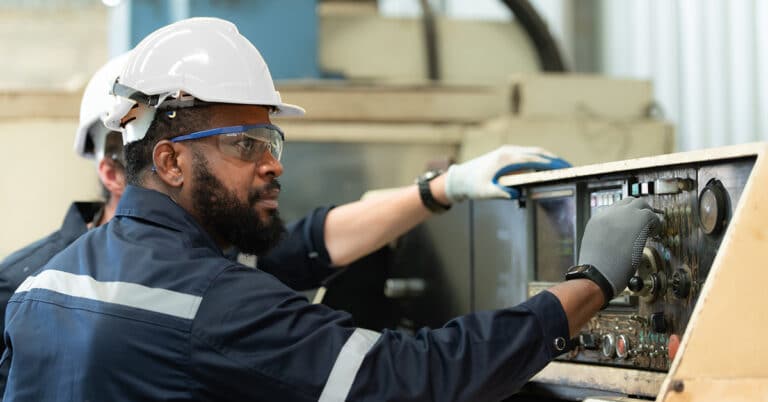“MOC” stands for “management of change”. Management of change is a process used to manage and control changes in manufacturing environments to limit risk and avoid the creation of new hazards.
Key components of MOC include change evaluation, approval, and implementation. While MOC is mandated under OSHA’s Process Safety Management (PSM) standard for any company that uses hazardous materials or chemicals, any company can benefit from the implementation of an MOC process.
In this piece, we’ll explore why MOC matters, when it is required, how companies can design and apply MOC processes, and what MOC best practices help streamline deployment.
Why MOC matters in manufacturing
MOC matters in manufacturing because it helps prevent the unintended consequences of change. These consequences could be small, such as increased downtime because newly deployed equipment doesn’t work seamlessly with older tools. The consequences may also be substantial. For example, if an industrial manufacturer implements a new chemical containment system and this system unexpectedly fails, the results may include injured staff and destroyed machinery, which require time, effort, and resources to address.
In practice, MOC offers five key benefits for manufacturers:
- Prevention of unintended consequences: The unintended consequences of equipment or process changes are costly. New machinery that doesn’t interact well with legacy tools may lead to unexpected downtime, which can cause missed production targets or lost revenue. New conveyors or other tools designed to improve product mobility, meanwhile, may lead to injury if improperly used. MOC maps out the impact of change to identify these consequences.
- Reduction of risks: Change may also lead to equipment damage or failure. For example, if new processes result in higher-than-expected operating temperatures, the result may be sudden failure or substantial damage. MOC finds these risks, assesses their impact, and identifies ways to reduce their likelihood.
- Education of staff and stakeholders: MOC includes training staff and stakeholders in what to expect when change happens, and what new processes will be put in place to reduce the impact of change. By training staff ahead of time, companies are better prepared to identify potential issues and respond when conflicts occur.
- Alignment with compliance and safety regulations: Change management may be required to align with compliance and safety requirements, such as those from OSHA or the Environmental Protection Agency (EPA). Consider a company using a new chemical formula to clean and sanitize machinery. MOC ensures this new formula is used in compliance with wastewater and hazardous material handling procedures.
- Development of a safety-first workplace culture: MOC helps put safety and accountability first. By anticipating rather than reacting to problems, companies can create a culture that encourages employees to speak up if they discover potential problems.
When is MOC required?
Under OSHA standard 29 CFR 1910.119 (I), Process Safety Management, documented and systematic MOC processes and procedures are required for any company that processes, stores, manufactures, or handles hazardous chemicals listed in OSHA’s Appendix A, and does so at or above what’s known as the threshold quantity, or TQ.
In theory, this means that not all companies require MOC. In practice, however, any organization that relies on equipment, processes, or materials that could potentially cause harm when operational changes occur can benefit from MOC.
Common scenarios for deploying MOC include:
- Equipment upgrades, replacements, or modifications
- Changes to raw materials, chemicals, or formulations
- Process control software or automation updates
- Organizational changes that impact job roles or responsibilities
- Modifications to facility layouts
- New suppliers or third-party maintenance providers
- Regulatory changes
Steps in the MOC process
While every MOC is unique, the framework for effective management of change is largely standardized into seven steps. Here’s a look at each in more detail:
1. Initiation: First is initiation. In this step, teams identify and document proposed changes. For a manufacturing company, this might be the deployment and integration of a new piece of production line machinery. This step should include a brief description of how the change will impact current productivity and what potential benefits it may bring.
2. Risk assessment: Next is risk assessment: What are the possible hazards or compliance issues associated with this change? In the case of new equipment, hazards might include unexpected failure or risks to operators. Compliance issues might include materials handling or disposal.
3. Review and approval: Once changes have been identified and risks have been assessed, companies can proceed to review and approve MOC processes. This step includes formal sign-offs from safety teams, engineering managers, and operations stakeholders.
4. Implementation: With the groundwork laid, companies can now implement changes while following the safety procedures outlined in MOC.
5. Communication and training: Pre-deployment training and post-deployment communication help ensure that staff understand new changes and are prepared to respond if and when issues occur.
6. Validation and documentation: Change should be tracked over time to validate predicted impact and verify success. In addition, companies need to document all changes in official records to meet compliance requirements.
7. Follow-up audits: MOC is not a static set of processes. Changes should be regularly reviewed and monitored to track their long-term impact, and your MOC should evolve in response to these changes.
Tools and systems that support MOC
The right tools and systems can help support the deployment and implementation of MOC processes. For example, computerized maintenance management systems (CMMS) can be integrated with MOC processes to streamline documentation and reporting processing.
Environmental, health, and safety (EHS) software, meanwhile, helps companies identify potential hazards, carry out risk assessments, and simplify approvals. Finally, condition monitoring systems help track the real-time status of key production line machinery.
These tools are underpinned by connected sensors and robust digital documentation. IoT-enabled sensors help validate changes and ensure that results align with expectations. Digital documentation, meanwhile, makes it easier for teams to collect and verify data around version control and traceability.
It’s also worth considering outsourced maintenance for complex or labor-intensive projects. Trusted third-party providers can handle machine performance tracking and upkeep, allowing teams to focus on building sustainable MOC processes.
MOC and compliance standards
Change management is a component in multiple manufacturing standards, including:
- OSHA PSM Standard 29 CFR 1910.119
- EPA Risk Management Plan (RMP) regulations
- ISO 45001 and ISO 9001 both include change control elements
MOC processes should be regularly reviewed and updated to ensure compliance. Many companies choose to evaluate and adjust MOC frameworks during audits and industrial maintenance safety inspections. In addition, it’s worth creating a regular schedule for MOC review to ensure processes keep pace with operations.
Poor (or absent) MOC implementations can lead to consequences. In the case of regulatory noncompliance, companies may face citations or fines. Across all industries, missing MOC processes may precede unexpected shutdowns if changes are not properly tracked and reviewed.
Best practices for implementing MOC programs
Building an effective MOC program doesn’t happen overnight. Instead, it is the product of concerted efforts to understand and evaluate the impact of change. Use these best practices to make MOC more effective:
- Standardize procedures: MOC processes should be standardized across your organization. This includes machine operators, maintenance crews, engineering means, and upper management. Anyone who interacts with affected tools or components should have access to the same change data.
- Train employees: Employees should be trained in how to follow MOC operating procedures and how to recognize the need for new change management. Consider a new piece of software designed to streamline equipment operations. If this software is applied companywide, it represents a significant change and should be handled under the MOC umbrella.
- Maintain communication: Consistent and clear communication across departments is critical for effective MOC. If one team initiates the change but doesn’t advise other sectors, this could lead to downtime or safety concerns.
- Use templates and checklists: Templates and checklists help companies identify changes using consistent formats. This makes it easier for staff to document when changes occur, what impacts they have, and how new risks can be reduced.
- Assign ownership: Ownership and accountability should be assigned at every stage of the process. At a high level, one C-suite executive should be the change leader, followed by the managers of engineering, maintenance, IT, and other relevant departments. Each owner should have a clear set of duties and responsibilities.
- Review and improve MOC processes: Regularly review MOC processes and improve these processes where necessary. While static processes will address immediate needs, flexibility is required to ensure ongoing MOC compliance.
The role of maintenance teams in MOC
Maintenance teams play a key role in change management. This is because maintenance teams are often the first to encounter or implement changes. For example, if a new process developed and implemented by engineers leads to a production problem, maintenance teams are first on the scene.
These teams may also be at the forefront of change implementation. Consider a maintenance professional who notices a recurring problem with specific industrial equipment. After reviewing the equipment’s specifications and predicted output, they recommend a change to improve reliability.
In both cases, maintenance team feedback is essential for assessing risk, planning work orders, and improving employee training. Comprehensive MOC also helps ensure that maintenance tasks tied to new equipment or processes are properly documented and safely executed. By aligning maintenance and production teams, companies get access to key MOC data from both sides of the operational coin.
Ensure operational efficiency and safety with MOC
Management of change processes enable safe, efficient, and adaptable manufacturing. This is because MOC protects the manufacturing revenue trifecta: people, processes, and equipment.
But MOC doesn’t stop there. As a dynamic set of operations, MOC helps manufacturers adapt to new innovations and implement new technologies without sacrificing control. Given the growing impact of solutions such as artificial intelligence (AI), machine learning (ML), and robotic process automation (RPA), MOC is more important than ever to help companies navigate the future of manufacturing.
Ready to make your MOC work for you? See how ATS can support change planning and implementation with skilled technicians and expert-led reliability programs. Let’s talk.






